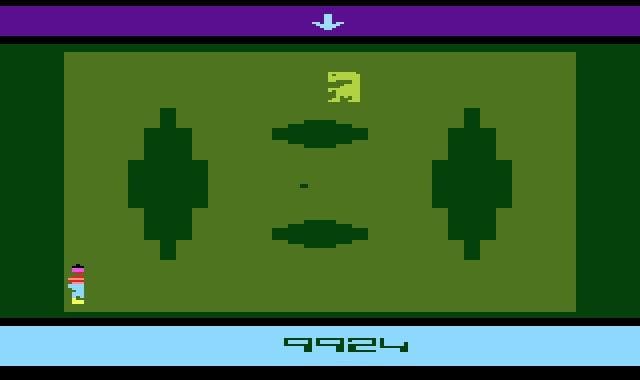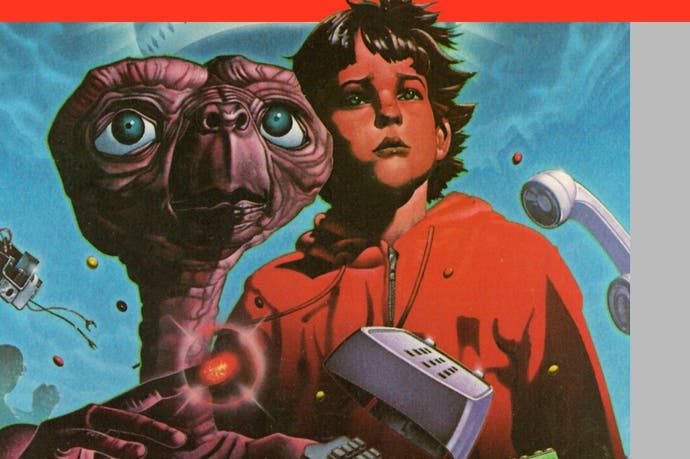Atari: Game Over review
Myth understanding.
Your reaction to this brisk documentary will depend largely on your feelings regarding the Atari 2600. If the thought of that console makes you weep tears of salty nostalgic joy, then you'll be in heaven. If you weren't a kid in America in the early 1980s then you'll find it interesting, if a little odd.
More specifically, the film is about the meteoric rise and equally rapid downfall of Atari, and the role played by the video game of E.T. the Extraterrestrial in that sorry saga.
There are two stories being told in tandem here. One is the inside story of Atari's riches to rags trajectory, as relayed by the people who were there. The other, famously, is the unearthing of a landfill site in Alamogordo, New Mexico, where thousands of unsold copies of the disastrous E.T. game were reportedly buried.
It's the former story that is more immediately engaging, though it suffers a little for being crammed into a 65 minute film amidst everything else. Howard Scott Warshaw, the designer who created Yar's Revenge and went on to produce the E.T. game, is the main point of focus, and the film is at its strongest when it simply lets him tell his story in his own way.
Most particularly, the scenes where he returns to the original Atari office building with director Zak Penn. There's real human interest here, not only in the sight of a great artist taking an emotional journey back to a place that holds great meaning for him, but in the candid nature of his recollections. His tales of drug-fuelled debauchery are tame by most other entertainment industry standards, but they're vital in humanising the process of game development.
There's insight too as the film delves into Atari's giddy early flush of success, courtesy of interviews with co-founder Nolan Bushnell and Manny Gerard from Warners, which bought Atari in the 1970s. Although these gents are familiar faces in many gaming documentaries these days, there's ample material here for a truly probing look at a company whose story is full of incident and drama. What was the role of E.T. in all of this? Well, it's here that things start to get muddled, and Game Over's attempt to have it both ways weakens its impact somewhat.

There's no denying that E.T. was a disaster waiting to happen, and the film carefully tracks its genesis, from the ground-breaking deal Atari struck with Universal, to the ludicrous five week development period that Warshaw had to work with, in order to deliver the game in time for Christmas 1982.
We learn that Spielberg himself personally signed off on the game, though the revelation that his response to Warshaw's ambition to create a game that mirrored the storyline and emotion of the film was "Can it be more like Pac-Man?" is rather wonderful.
We all know what happened next. The game sold well, but was so bad that players turned on Atari almost overnight. Sales plummeted, share prices followed and Atari hurriedly buried all the copies of the game in the desert, out of sight and hopefully out of mind. That's the popular story, anyway, and it's one that the film tackles in its most headline-friendly but narratively inert strands.
According to Microsoft's own promotional text on the Xbox website, this is "one of the biggest mysteries of all time", which as hyperbole goes is pretty bold. It's not even the greatest gaming mystery of all time, nor is it strictly a mystery. That Atari buried games at Alamogordo is a matter of public record. The exact location within the landfill and the specific contents of what was dumped are - or were - unknown, but this is one of those weird situations where a mystery has grown up around something that isn't really that mysterious. It's less urban myth and more modern meme.
Nevertheless, the excavation of the site makes for a compelling stunt on which to hang the rest of the film, but what could have been a fun little stinger at the end is treated with way too much gravitas. We see "waste disposal expert/historian" Joe Lewandowski poring over archive photos of the dump, working out where the cartridges might be, with transparent overlays and colour coded lines of sight, with all the forensic rigour you'd expect from someone tracking an assassin's bullet. We even meet the municipal New Mexico bureaucrats whose permission is needed to go ahead with the dig. Will the pencil pushers block the excavation for fear of releasing deadly gas? Nope. But the chance to manufacture a little needless tension is seized a little too readily all the same.
We also get to follow geek author Ernest Cline, whose novel Ready Player One has earned him gamer celebrity status, as he makes a pilgrimage to the site in his Back to the Future styled DeLorean, accompanied by a life-sized E.T. Why? Because it's sort of cute, I guess.
The hushed reverence as the clearly bemused landfill workers burrow into thirty years of crap is more than a little laughable. A sandstorm blows up, prompting comparisons to Close Encounters of the Third Kind and Raiders of the Lost Ark. A broken Atari joystick is held up as evidence that the Grail is about to be found. It's all a bit silly, and while you suspect the film knows this, it can't openly admit it because the whole premise of the film up to this point has been hung on this "discovery".
But maybe I'm just not feeling it. Part of my problem with this story - or more specifically how this story is framed - is that not only has the role of E.T. in the big video games industry crash of 1983 been overplayed, but the nature of the crash itself requires a culturally blinkered view that I simply don't have. In 1983, the British games industry was in rude health. Similarly, Japan saw the entry into the console market of both Nintendo and Sega at the same time. This industry crash was really a regional blip, centred on a single company.
I certainly get the importance for those who were there. I was lucky enough to be working in the same offices as Retro Gamer magazine when they took delivery of the original development discs for Matthew Smith's unfinished Jet Set Willy sequel, codenamed Mega Tree, and that felt suitably important. If anyone ever discovers material from Ultimate's Mire Mare, I'll probably swoon a little. But, all cultural bias aside, those are genuine legends - games that never got to exist, where the evidence of their potential is limited and precious.
E.T. was published. It sold millions of copies. Far from being truly lost, you can still pick copies up on eBay for a few quid or download a ROM for your emulator of choice. So, sad to say, I didn't really feel much of a chill down my spine at the news that some copies that were buried three decades ago turned up exactly where they were left. Rather cheekily, the film eventually and belatedly admits as much, and having built up its big finale, reveals that it wasn't that important after all.

What follows is the real message of the film - a call for Warshaw's reputation to be restored and reclaimed from the very same scurrilous misinformation that the preceding 50 minutes have relied upon so heavily. The E.T. game was certainly hard and unfair, but it was also ambitious and far from being the worst game on the Atari 2600, let alone of all time. It's a sweet and convincing climax that finally brings the tale back to more interesting terrain, but the narrative bait and switch needed to get there feels more than a little disingenuous.
One thing Game Over does do incredibly well - and the area where it shows up the recent glut of gaming documentaries for the well-intentioned amateur projects they are - is in how well it's been put together. Producer Simon Chinn has won two Oscars for films such as Man on Wire and Searching for Sugar Man. Director Zak Penn is probably best known for working as a writer on early comic book movies such as X-Men 2 and Hulk, and he's also directed a wonderful film with Werner Herzog about the Loch Ness Monster. These are people who know how to shoot coverage, how to create a story through editing, and how to structure a film with set-ups and pay-offs that feel narratively satisfying.
It all feels frustratingly truncated in an hour-long show. It was supposed to be the first episode in Xbox Original's Signal to Noise series of factual films, but with Microsoft's entertainment division now closed down, it's unclear what that actually means. Certainly, for a project developed for digital viewing, it's a shame it's been squeezed into a running time better suited to broadcast TV, and it'd be a pity if a longer, more detailed look at this story was left on the cutting room floor in order to fit in with a series that may now never happen.
A feature length film about Howard Warshaw's time at Atari, as one of the creative minds that would help define an entirely new medium while ingesting heroic amounts of narcotics, would be fascinating. Similarly, the hubris that saw Atari over-extend itself, and CEO Ray Kassar forced out amid allegations of insider trading, would make for a compelling corporate documentary regardless of whether you're invested in gaming itself.
That these stories - deeper, richer but not immediately sexy - have to take a back seat to people digging a hole in the desert is a shame. Yet even with these flaws, Atari: Game Over is still one of the best films about gaming this year and should be seen by anyone with an interest in the medium's early wild west years.










